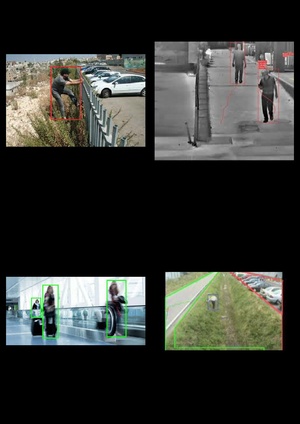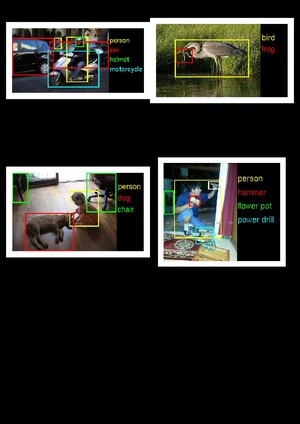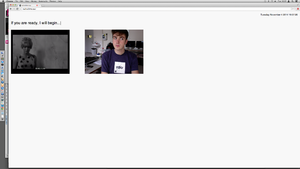User:Max Dovey/Reading Writing Research Methodologies/maxdgradprop2
Title
When the technology performs (Working Title)
Project
What I am proposing for my graduate project in June is a work that is built upon two elements that combine real-time media and live performance. The first is real-time webcams and the second is how computer software can now interpret (moving) images.
I am interested in the authenticity of live media and the way it mediates performance with real-time experience. By mediating live acts of performance with real-time computing and artificial intelligence programs the technology can interpret and respond to live action.
I intend on generating narratives through the process of instant (mis)interpretation and look at the authenticity of real-time media. This method of performance relates to my research into how the immediate and the authentic of the live act is mediated with technology.
Tech requirements
-
A rough tech list
- 2 projectors
- 1 screen 5m x 3.5m
- A staged area for performance opposite projection screen 7m x 5m
- A 2.4mbps ethernet internet connection
Intro
Performance art has a long history of challenging the relationship between technology and the live aura and the discussion over reproduction and live art documentation has been fought since the 1960s.
We now find that Walter Benjamin’s essay Art In The Age Of Technical Reproducibility (1936) needs to be revised, as artists are utilizing real-time technology and wireless networks to generate live performances in immediate and distant locations.
When referring to the aura of performance I identify it as the unexpected, the improvised nature of the live moment that cannot be recreated.
Computers can now operate within the live moment, processing and responding with the action so that the technology is no longer a reproduction detached from its authentic origin but a player in the act; generating the aura of the live moment in a relational mediation of events.
My wider inquiry for the graduation project is how does technology mediate performance and our experience of liveness?
Practical Steps
Webcams
My interest in real-time led me to webcams and I’ve made some prototypes exploring different methods for performing with video streams. I’ve located webcams from an online community (opentopia) where there is a small group of regular watchers who comment on the webcams like reality T.V.
In these examples I perform the viewer’s comments by reading them out loud or creating subtitles text onto the webcam so the metadata becomes embedded into the same image and creates a performance on the act surveillance.
I have begun some small prototypes to begin this process –
- I admire them they can do this (French Living Room)
- Reading out viewer comments to webcam.
- http://headroom.pzwart.wdka.hro.nl/~max/frenchlivingroom.html
- Mummy Dorset
- Creating compilation of webcams based on one user and their timestamps.
- http://headroom.pzwart.wdka.hro.nl/~max/mommydorset.html
- AmaksHotel
- Performance between 2.15pm - 2.35pm (GMT) on 24/11/2014 Real-time script generated by users in chat window
- http://youtu.be/Xddk969CcKM
- webcam interruption –
- Working with I have been creating interruptions to reveal the latency and the mediation of the technology.
- http://headroom.pzwart.wdka.hro.nl/~max/24fps/ Surveillance
- Networked performance –
- In collaboration with an artist in London we have begun planning durational-based pieces that occur simultaneously in two different locations. We are interested in how two events can be performed with real-time technology.
- Last December we began performing in real-time in different locations
- http://3screens.eu/
- November – Letters and The postal system This text will be a hand written letter based on Kafka’s ‘Letters to Felice’ (1914)
- January – Telephony and telecommunication Early Telephone performance work (still need to be located)
- March – Radio and the Wireless Orson Well’s ‘War of the Worlds’ (1938)
- May – Television and TV Broadcasting Live Televised performance possibly based on TV Interuptions by David Hall of Artist Placement Group (1971)
- June – Internet and Real-time streaming Performance installation as part of Piet Zwart Media Design and Communication graduation show.
- Tate Modern BMW Tate Live http://www.tate.org.uk/whats-on/tate-modern/eventseries/bmw-tate-live-2014-performance-room [Accessed on 30 October 2014]
- Blast Theory – Karen http://www.blasttheory.co.uk/projects/Karen [Accessed on 30 October 2014]
- Kit Galloway & Sherrie Rabinowitz – Hole in Space http://turbulence.org/blog/2014/07/08/the-mother-of-all-video-chats-a-hole-in-space-la-ny-1980/ Books
- Liveness and Performance in a Mediated Culture, Phillip Auslander, 1999
- Unmasked: The politics of performance, Peggy Phelan, 1993
- Theatre and Performance in Digital Culture, Matthew Caurey, 2006
- Art in the Age of technical reproducibility, Walter Benjamin, 1936
- Letters to Felice, Franz Kafka, 1914 Audio
- Orson Wells ‘War of the Worlds’ https://www.youtube.com/watch?v=Xs0K4ApWl4g [accessed on 4 November 2014]
Throughout these experiments I have been trying to establish my angle on surveillance cameras and wanting to bring my practice of performance and improvising technology to the webcam medium.
I began researching the wider field of surveillance cameras.
The majority of surveillance cameras are not actually being watched by a human. Video content analysis software is programmed to alert if an action is detected that is ‘unusual’. Video content analysis will detect humans, gender, weather someone has a bag, and interpret what is going on within the scene.
This analysis interests me because there is a computational process of interpretation going on (similar to speech-to-text) where the computer program is detecting what is happening and translating the live events into data.
I have been looking at how images can be registered by computational processing and the development of computer vision. These are samples of image annotation where the computer automatically labels elements within the frame.
Previous Work
http://vimeo.com/ 95677127
‘Foley Narrative’ 2014
Throughout my time at the Piet Zwart Institute I have developed a methodology for performing with computational data and a live audience.
In ‘Foley Narrative’ (2014) speech to text software ‘listens’ to the noise I create with objects and translates my actions into words that are projected on screen. The relations between the objects and myself are interpreted by the computer speech to text and program and generate an instant (mis)interpretation. I improvise with the direct mediation between the performance and the computer’s interpretation of my act.
More recently I have performed an analysis of real-time technology. In ‘Real-real-time’ (2014) I examine the representation of live in film and computers, deconstructing the illusion of ‘real-time’ and analysing different temporal illusions in media that depict reality. Presenting the illusion of liveness in technology allows us to see the affects of technological mediation of our sense of time. The website uses a live video stream to mirror the viewer into a real time representation.
http://vimeo.com/ 19704973
'Twitter Theatre' 2010
In ‘Twitter Theatre’ (2010) performers improvise from real time twitter feeds that are projected into the space.
The performers respond to the continuous streams of data by using the tweets as scripts for an improvised performance.
Here performers react with the speed of networked technology and create a performance between live data and the audience.
Relation to a larger context
There is an unknown encounter happening in the live moment that is beyond reproduction. This can be seen in the unexpected encounters created by a video stream that was installed on the streets of LA and New York in an early telepresent work ‘Hole in Space’ by Kit Galloway & Sherrie Rabinowitz.
The use of chatbots or A.I. is an obvious example of how a computer’s instant feedback can perform in an improvised nature and generate the unexpected tension in the authentic live moment.
Blast Theory’s latest project ‘Karen’ is performed through a video therapist available to download as a mobile app.
The app generates a data driven story in response to the user’s interactions and demonstrates how the role of computing and real time technology creates suspense and improvises responses that create unexpected encounters.
Blast Theory are a contemporary example of a performance history that can be traced from Futurist performances, Fluxus, Allan Kaprow’s Happening’s, John Cage, Sheer Doruff’s networked installations and Tate Modern’s video streaming platform ‘BMW Tate Live’. Artists and organizations across a broad cultural field are challenging how performance can be experienced with networked technology.
The theoretical context is currently situated between arguments put forward by Phillip Auslander in ‘Liveness’ (1999), Peggy Phelan’s ‘Unmarked’ (1993) and Matthew Caurey’s ‘Theatre and Performance in Digital Culture’ (2006).
These three texts all describe performance in reference to the Walter Benjamin text ‘Art in the age of technical reproducibility’ (1936). Their writing will support my practice in locating the authentic in performance with networked technologies and provide a critical framework for my graduate project.
Thesis Plan
My Thesis plan will be an investigation of performance with different communication networks. I am interested in how the medium has changed the way artists have performed live work, and locating examples of the technology performing with a live or durational-based artwork. My investigation will survey the major communication networks of the last century looking at how each medium has affected performance based art works.
I have asked 10 artists to participate in this research by responding to each text with a small action or performance. The texts will contain a short set of instructions that will directly ask the reader to perform a live action in response to the text. The response will be documented and form part of the research.
Each text will be an analysis of how each medium has been applied in performance acts.
These experiments in performing via communication technology will become a survey of research on the effects of mediation on performance.
My thesis will present a collaborative performance with networked mediums that reflect on the relation between the live act and the network medium.
Refs
-
URLS



